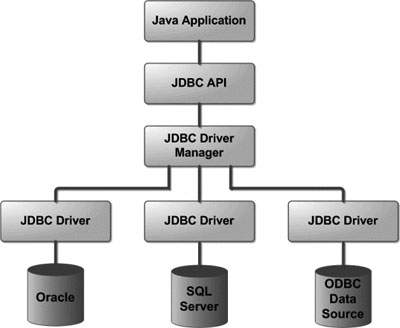JDBC入门学习
Posted Emma
tags:
篇首语:本文由小常识网(cha138.com)小编为大家整理,主要介绍了JDBC入门学习相关的知识,希望对你有一定的参考价值。
Introduction
What\'s JDBC
JDBC stands for Java Database Connectivity, which is a standard Java API for database-independent connectivity between the Java programming language and a wide range of databases.
JDBC library (includes APIs)的主要用途包括
-
Making a connection to a database. 连接数据库
-
Creating SQL or mysql statements. 创建SQL或者MySQL语句
-
Executing SQL or MySQL queries in the database. 执行SQL或者MySQL查询
-
Viewing & Modifying the resulting records. 查看或者修改结果
JDBC架构
JDBC支持两层或者三层处理逻辑。但是一般,包括两层结构
-
JDBC API: This provides the application-to-JDBC Manager connection.
-
JDBC Driver API: This supports the JDBC Manager-to-Driver Connection.

JDBC drivers实现了JDBC APIs定义的接口。
JDBC连接
连接JDBC通常有四个简单的步骤
-
Import JDBC Packages: Add import statements to your Java program to import required classes in your Java code.
-
Register JDBC Driver: This step causes the JVM to load the desired driver implementation into memory so it can fulfill your JDBC requests.
-
Database URL Formulation: This is to create a properly formatted address that points to the database to which you wish to connect.
-
Create Connection Object: Finally, code a call to the DriverManagerobject\'s getConnection( ) method to establish actual database connection.
注册JDBC driver
注册JDBC driver有两种方法:
Approach 1: Class.forName() 自动将driver相关class加载到内存

try { Class.forName("oracle.jdbc.driver.OracleDriver"); } catch(ClassNotFoundException ex) { System.out.println("Error: unable to load driver class!"); System.exit(1); }
Approach 2: DriverManager.registerDriver() 如果使用的是 non-JDK compliant JVM

try { Driver myDriver = new oracle.jdbc.driver.OracleDriver(); DriverManager.registerDriver( myDriver ); } catch(ClassNotFoundException ex) { System.out.println("Error: unable to load driver class!"); System.exit(1); }
Database URL formulation
加载完driver之后,可以用DriverManager.getConnection()建立连接。
下面是常用数据库与connection URL的映射表
| RDBMS | JDBC driver name | URL format |
|---|---|---|
| MySQL | com.mysql.jdbc.Driver | jdbc:mysql://hostname/ databaseName |
| ORACLE | oracle.jdbc.driver.OracleDriver | jdbc:oracle:thin:@hostname:port Number:databaseName |
| DB2 | COM.ibm.db2.jdbc.net.DB2Driver | jdbc:db2:hostname:port Number/databaseName |
| Sybase | com.sybase.jdbc.SybDriver | jdbc:sybase:Tds:hostname: port Number/databaseName |
JDBC statement,PreparedStatement & CallableStatement
根据不同的需用,可以选择不同的statement接口。
| Interfaces | Recommended Use |
|---|---|
| Statement | Use for general-purpose access to your database. Useful when you are using static SQL statements at runtime. The Statement interface cannot accept parameters. |
| PreparedStatement | Use when you plan to use the SQL statements many times. The PreparedStatement interface accepts input parameters at runtime. |
| CallableStatement | Use when you want to access the database stored procedures. The CallableStatement interface can also accept runtime input parameters. |
Statement
创建statement

Statement stmt = null; try { stmt = conn.createStatement( ); . . . } catch (SQLException e) { . . . } finally { . . . }
执行statement
创建完statement object之后,可以用来执行SQL语句
-
boolean execute (String SQL): Returns a boolean value of true if a ResultSet object can be retrieved; otherwise, it returns false. Use this method to execute SQL DDL statements or when you need to use truly dynamic SQL.
-
int executeUpdate (String SQL): Returns the number of rows affected by the execution of the SQL statement. Use this method to execute SQL statements for which you expect to get a number of rows affected - for example, an INSERT, UPDATE, or DELETE statement.
-
ResultSet executeQuery (String SQL): Returns a ResultSet object. Use this method when you expect to get a result set, as you would with a SELECT statement.
关闭statement
如果close connection节省数据库资源一样,close statement可以确保资源的合理回收。

Statement stmt = null; try { stmt = conn.createStatement( ); . . . } catch (SQLException e) { . . . } finally { stmt.close(); }
JDBC 批处理
批处理(batch processing)允许一次执行多条SQL语句。由于JDBC drivers并没有要求实现这个功能,因此使用前先用 DatabaseMetaData.supportsBatchUpdates() 检测目标数据库是否支持批处理。
Statement对象的批处理
-
Create a Statement object using either createStatement() methods.
-
Set auto-commit to false using setAutoCommit().
-
Add as many as SQL statements you like into batch using addBatch()method on created statement object.
-
Execute all the SQL statements using executeBatch() method on created statement object.
-
Finally, commit all the changes using commit() method.

// Create statement object Statement stmt = conn.createStatement(); // Set auto-commit to false conn.setAutoCommit(false); // Create SQL statement String SQL = "INSERT INTO Employees (id, first, last, age) " + "VALUES(200,\'Zia\', \'Ali\', 30)"; // Add above SQL statement in the batch. stmt.addBatch(SQL); // Create one more SQL statement String SQL = "INSERT INTO Employees (id, first, last, age) " + "VALUES(201,\'Raj\', \'Kumar\', 35)"; // Add above SQL statement in the batch. stmt.addBatch(SQL); // Create one more SQL statement String SQL = "UPDATE Employees SET age = 35 " + "WHERE id = 100"; // Add above SQL statement in the batch. stmt.addBatch(SQL); // Create an int[] to hold returned values int[] count = stmt.executeBatch(); //Explicitly commit statements to apply changes conn.commit();
PreparedStatement对象的批处理

// Create SQL statement String SQL = "INSERT INTO Employees (id, first, last, age) " + "VALUES(?, ?, ?, ?)"; // Create PrepareStatement object PreparedStatemen pstmt = conn.prepareStatement(SQL); //Set auto-commit to false conn.setAutoCommit(false); // Set the variables pstmt.setInt( 1, 400 ); pstmt.setString( 2, "Pappu" ); pstmt.setString( 3, "Singh" ); pstmt.setInt( 4, 33 ); // Add it to the batch pstmt.addBatch(); // Set the variables pstmt.setInt( 1, 401 ); pstmt.setString( 2, "Pawan" ); pstmt.setString( 3, "Singh" ); pstmt.setInt( 4, 31 ); // Add it to the batch pstmt.addBatch(); //add more batches . . . . //Create an int[] to hold returned values int[] count = stmt.executeBatch(); //Explicitly commit statements to apply changes conn.commit();
References
http://www.tutorialspoint.com/jdbc/jdbc-where-clause.htm
http://stackoverflow.com/questions/2839321/connect-java-to-a-mysql-database
以上是关于JDBC入门学习的主要内容,如果未能解决你的问题,请参考以下文章
